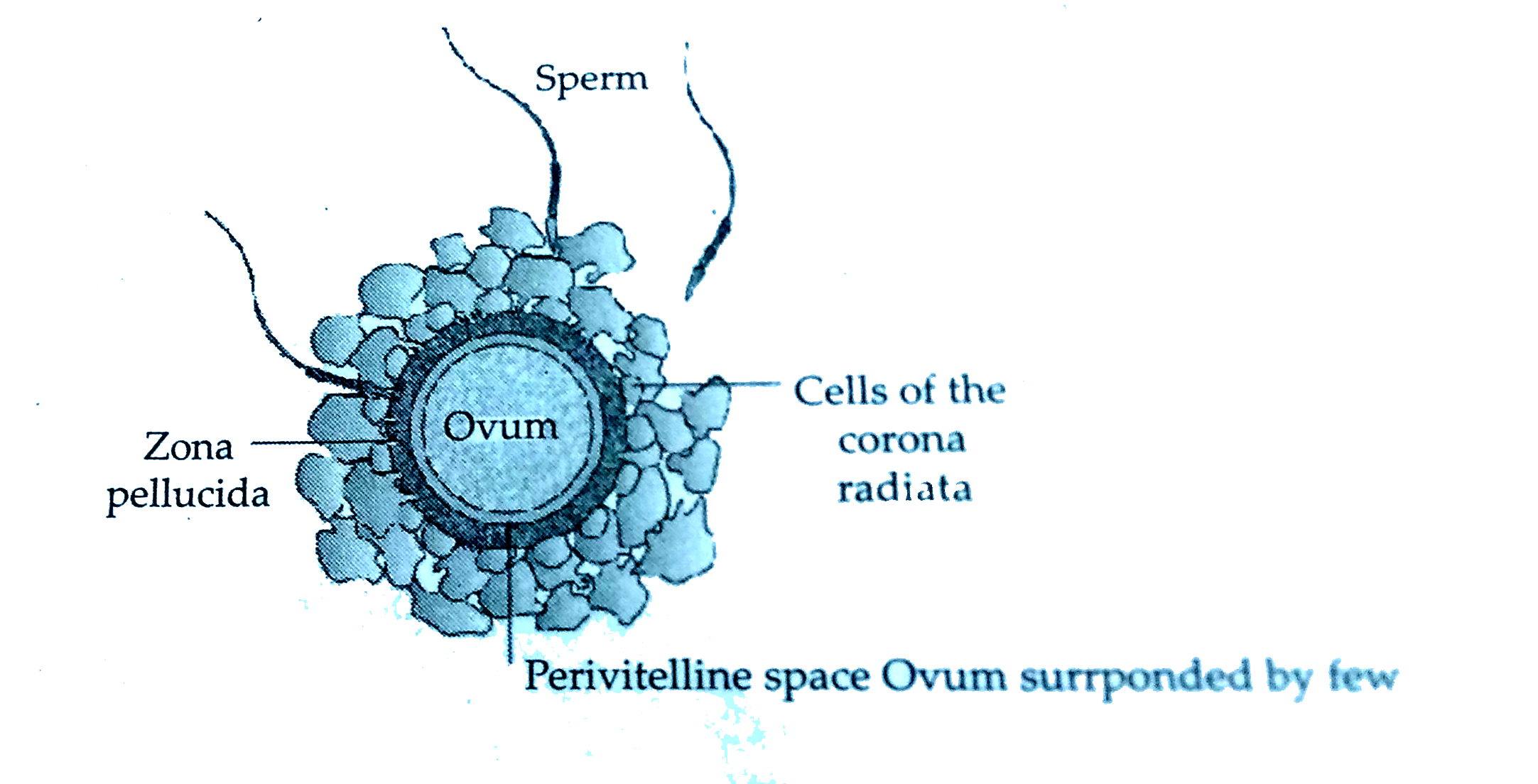(a) Explain the events taking place at the time of fertilization of an ovum in a human female.
(b) Trace the development of the zygote upto the implanation in the uterus.
(c) Name and draw a labelled sectional view of the embryonic stage that gets implanted.
(a) Fertilisation :
(i) The process of fusion of a sperm (male gamete) with an ovum (female gamete)is called fertilisation.

(ii) During coitus, semen is released by the penis into the vagina (insemination).
(iii) The motile sperms swim rapidly. through the cervix, enter into the vagina (insemination).
(iv) The motile sperms swim rapidly, through the cervix, into the uterus and reach the ampullary- isthmic junction of the oviduct.
(v) A sperm comes in contact with the zona pellucide layer of the ovum and induces changes in the membrane to block the entry of additional sperms.
(vi) The enzymes of the acrosome of sperm help to dissolve zona pellucida and plasma membrane of the ovum and sperm head is allowed to enter into the cytoplasm of the ovum, i.e., secondary oocyte. ffitimately, diploid zygote is produced by the fusion of a sperm and an ovum.
(b) Implantation : (i) Zygote divides rapidly by mitiotic division called cleavage and as a result 2, 4, 8, 16 daughter cells are produced which are termed as blastomeres.
(ii) Embryo with 8-16 blastomeres is called a morula.
(iii) The morula changes into a large mass of cells called blastocyst which passes further into the uterus.
(iv) Blastomeres in the blastocyst are arranged into an outer layer called trophoblast and an inner group of cells attached to trophoblast called inner cell mass.
(v) The trophoblast layer gets attached to the cells of the endometrium and the inner cell mass gives rise to the embryo.
(vi) The cell of endometrium divide rapidly and cover the blastocyst.
(vii) The blastocyst gets embedded in the endometrium of the uterus called implantation of pregnancy.
(viii) The Embryonic stage that gets implanted is called blastocyst

Topper's Solved these Questions
- XII BOARDSBOOK - XII BOARD PREVIOUS YEAR PAPER ENGLISHCHAPTER - XII BOARDSEXERCISE - SECTION -A
11 Videos
- XII BOARDSBOOK - XII BOARD PREVIOUS YEAR PAPER ENGLISHCHAPTER - XII BOARDSEXERCISE - SECTION -B
12 Videos
- XII BOARDSBOOK - XII BOARD PREVIOUS YEAR PAPER ENGLISHCHAPTER - XII BOARDSEXERCISE - SECTION-C
86 Videos
- SAMPLE PAPER 2019BOOK - XII BOARD PREVIOUS YEAR PAPER ENGLISHCHAPTER - SAMPLE PAPER 2019EXERCISE - Section E Part B
3 Videos
Similar Questions
Show diagrammatically the stages of embryonic development from zygote upto implantation in humans .

View SolutionName the embryonic stage that gets implanted in the uterine wall of a human female.
View SolutionExplain the development of a secondary oocyte ( ovum) in a human female from the embryonic stage upto its ovulation. Name the hormones involved in this process.
View Solution(a) Draw a labelled diagram of the sectional view of microsporangium of an angiosperm.
(b) Explain the development of male gametophyte in the microsporangium.
View SolutionGiven below are diagrams showing the different stages in the process of fertilisation of an egg in the human female reproductive tract.
Study the diagrams and answer the questions

(i) Arrange the letters given below each diagram in a logical sequence to show the correct order in the process of fertilisation.
(ii) Where does fertilisation normally take place? What is 'Implantation' that follows fertilisation ?
(iii) Mention the chromosome number of the egg and zygote in humans.
(iv) Explain the term 'Gestation'. How long does Gestation last in humans ?
(v) Draw a neat, labelled diagram of a mature human sperm.
View Solutionthe stages of oogenesis in human females.
(b) Draw a labelled diagram of a human ovum released after ovulation.
View Solution(a) Explain the different ways apomictic seeds can develop. Give an example of each.
(b) Mention one advantage of apomictic seeds to farmers.
(c ) Draw a labelled mature stage of a dicotyledonous embryo.
View SolutionDraw the following diagrams related to human reproduction and label them.
(a) The zygote after the first cleavage division
(b) Morula stage
(c) Blastocyst stage (sectional view)
View SolutionDraw the following diagrams related to human reproduction and label them.
(a) The zygote after the first cleavage division
(b) Morula stage
(c) Blastocyst stage (sectional view)
View SolutionThe following is the illustration of the sequence of ovarian events (a - 1) in a human female. (a) Identify the figure that illustrates ovulation and mention the stage of oogenesis it represents.
(b) Name the pituitary hormone that has caused the above mentioned event.
(c) Explain the changes that occur in the uterus simultaneously in anticipation
(d) Write the differences between 'c and 'h'.
(e ) Draw a labelled sketch of the structure of a human ovum prior to fertilization.

View Solution
